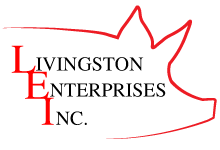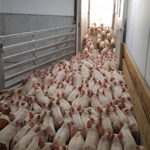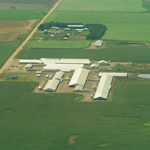Livingston Enterprises . . . A Study in Persistence and Commitment
Jefferson County, Neb., pork producer Bruce Livingston is a poster child for how hard work and unyielding persistence pays off. At age 36, Livingston is the owner of Livingston Enterprises, Inc., a 6,200-sow breed-to-wean operation in Fairbury, Neb., and is arguably one of the most efficient pork producers in the country.
But unlike m any pork producers, Livingston always wanted to be a pork producer. “I started in the hog business when I was eight years old,” Livingston recalls with a smile. “I started with six breeding females that I purchased from money earned working for my dad, uncles and a gilt that I won in a judging show, and I knew right then this was my life’s dream.”
any pork producers, Livingston always wanted to be a pork producer. “I started in the hog business when I was eight years old,” Livingston recalls with a smile. “I started with six breeding females that I purchased from money earned working for my dad, uncles and a gilt that I won in a judging show, and I knew right then this was my life’s dream.”
By the time he was a senior in high school in 1987, he was up to 150 sows. When profits allowed him, he gradually expanded his operation. By 1995 he had grown to 600 sows farrow-to-finish. In 1996 he realized the need for high-quality, single-source Isowean pigs and quickly converted his 600-sow operation to all breed-to-wean and expanded his operation to 2,200 sows. Following the success of his Isowean business, Livingston once again expanded in 1997 to 3,200 sows, and by 2000 had built the herd to 5,200 sows. Now in 2006, he currently sits at 6,200 sows.
From a quick review of his business, one would quickly surmise that he is a success story. But Livingston will be the first to tell you he has a lot more left to accomplish in his pork enterprise and sitting back on his success is not one of them. A good example is his recent expansion. Livingston has added a new 8,000-head finishing site where he finishes about 10% to 15% of his own production. In the spring of 2007, Livingston is planning on breaking ground for a new 5,000-head sow unit. Within five years he hopes to expand his operation to 20,000 sows.
But Livingston will quickly remind you that it hasn’t always been a dream to keep the wheels from falling off his venture.
 “Like all pork producers, I was faced with challenges,” the producer notes. “For my operation the biggest challenge came in the form of PRRS. I basically had the same herd of mixed genotypes and genetics for 24 years. I started to see my operation’s production drop due to heterosis issues and the introduction of PRRS strains and secondary diseases. While my staff and I did a good job of keeping PRRS from affecting our sow herd, the disease started to weigh heavily in the nursery stages for my Isowean customers.
“Like all pork producers, I was faced with challenges,” the producer notes. “For my operation the biggest challenge came in the form of PRRS. I basically had the same herd of mixed genotypes and genetics for 24 years. I started to see my operation’s production drop due to heterosis issues and the introduction of PRRS strains and secondary diseases. While my staff and I did a good job of keeping PRRS from affecting our sow herd, the disease started to weigh heavily in the nursery stages for my Isowean customers.
“Early in 1996, a Danbred rep dropped off 10 bags of semen for me to try in the herd,” recalls Livingston. “I was impressed almost immediately with the results. They were heads above what I was accomplishing with my mixed genetics herd. The next thing I know, I’m up at their boar stud touring their lab, discussing their research methods, production data and selection criteria.
“It’s not very often that you find a company that has the same business directives as you do,” Livingston adds. “They are focused on improving sow production and overall throughput costs from the breeding gilt to the finishing animal. This business directive helped me decide to convert my entire herd over to Danbred genetics.
“Danbred also has great staff to work with,” he adds. “They’ve changed their selection rate so that 70% of their selection is based on pig survivability at Day 5. That’s critical to my business. I like the fact that their R&D is driven off of cost-of-production from the breeding gilts to the market hog. They’re looking at every part of production. That’s critical to me now and in the future.”
Livingston also notes that it was their prolific breeding animals that ultimately drew him to Danbred.
“The production numbers I’ve seen are impressive,” the producer notes. “The key to my operation’s success is having more pigs born live. I was looking for the genetics that would not only produce more born-live pigs, but also the most thrifty, viable pig possible. That starts for us as good live born weights. Danbred has delivered on that factor.
“I’ve managed a lot of different genotypes in my system and feel with our management system we can make most genotypes produce well for us,” he admits. “However, these Danbred animals consistently give us the live pigs to work with. They are phenomenal. I feel strongly that we have the best animal in the industry.”
Livingston recently went through a depop/ repop program (fall, 2004) and stayed with Danbred throughout the repop program.
“I had the same herd for 24 years,” he admits. “Every time I added new animals, the production was suffering. Then PRRS came in and started taking our numbers down. When we broke with a third strain of PRRS, I decided we would never reach our production goals unless we converted to a single-sourced breeding herd. Danbred was large enough to be able to fill my facility in the time line that I wanted. That was critical to us staying on target.”
Livingston notes that they’re just now farrowing parity three females (and several parity one and two females) and they’re already getting up to 27.5 pigs/sow/year. “My goal is 30+ pigs/sow/year and I have confidence we can reach that number with this sow,” Livingston predicts. “Danish pork producers who are using these genetics have a history of consistently producing 30+ pigs per sow per year.”
 Livingston is in the process (following the repop) of switching over to Danbred’s new 241 true F1 (half Large White/half Landrace). Following the repop program with Danbred genetics, Livingston Enterprises’ live-born average is 11.7 and weaning average is around 11 for a 94% survival rate. “The Danbred’s 241 line F1 females are having 12 live born and pushing 13,” Livingston outlines. Prewean mortality is only 6% vs. the industry average of 12% to 14%.
Livingston is in the process (following the repop) of switching over to Danbred’s new 241 true F1 (half Large White/half Landrace). Following the repop program with Danbred genetics, Livingston Enterprises’ live-born average is 11.7 and weaning average is around 11 for a 94% survival rate. “The Danbred’s 241 line F1 females are having 12 live born and pushing 13,” Livingston outlines. Prewean mortality is only 6% vs. the industry average of 12% to 14%.
Livingston adds that he has excellent employees who all work hard to keep improving production. He also says a critical eye towards proper management is essential to be able to reach these numbers. For example, he has invented a farrowing crate that allows the sow to lie down slow and thus reduce lay-ons. The operation also employs some excellent cross-fostering programs to maintain piglet livability. According to the producer, these management techniques all play a huge role in their overall production numbers.
Livingston adds, “I’ve just entered a contract to provide Danbred 482 F2 gilts (241 x 241). These are absolutely beautiful gilts. I can confidently say that these Danbred F2 gilts would stand toe-to-toe with most genetic companies’ F1 gilts. They are truly excellent breeding females that are producing consistently large litters.”
Bruce Livingston has established yet another goal for his operation. “My goal is to own and oversee the first large-scale farm in North America to consistently raise 30+ pigs,” he concludes confidently. “Give this operation a year or two to get all Danbred F1 females in the herd and I believe we’ll reach those numbers.”
No one doubts Bruce Livingston’s prediction or his dedication to making it become a reality.
Livingston Enterprises . . . A Study in Persistence and Commitment
Jefferson County, Neb., pork producer Bruce Livingston is a poster child for how hard work and unyielding persistence pays off. At age 36, Livingston is the owner of Livingston Enterprises, Inc., a 6,200-sow breed-to-wean operation in Fairbury, Neb., and is arguably one of the most efficient pork producers in the country.
But unlike m any pork producers, Livingston always wanted to be a pork producer. “I started in the hog business when I was eight years old,” Livingston recalls with a smile. “I started with six breeding females that I purchased from money earned working for my dad, uncles and a gilt that I won in a judging show, and I knew right then this was my life’s dream.”
any pork producers, Livingston always wanted to be a pork producer. “I started in the hog business when I was eight years old,” Livingston recalls with a smile. “I started with six breeding females that I purchased from money earned working for my dad, uncles and a gilt that I won in a judging show, and I knew right then this was my life’s dream.”
By the time he was a senior in high school in 1987, he was up to 150 sows. When profits allowed him, he gradually expanded his operation. By 1995 he had grown to 600 sows farrow-to-finish. In 1996 he realized the need for high-quality, single-source Isowean pigs and quickly converted his 600-sow operation to all breed-to-wean and expanded his operation to 2,200 sows. Following the success of his Isowean business, Livingston once again expanded in 1997 to 3,200 sows, and by 2000 had built the herd to 5,200 sows. Now in 2006, he currently sits at 6,200 sows.
From a quick review of his business, one would quickly surmise that he is a success story. But Livingston will be the first to tell you he has a lot more left to accomplish in his pork enterprise and sitting back on his success is not one of them. A good example is his recent expansion. Livingston has added a new 8,000-head finishing site where he finishes about 10% to 15% of his own production. In the spring of 2007, Livingston is planning on breaking ground for a new 5,000-head sow unit. Within five years he hopes to expand his operation to 20,000 sows.
But Livingston will quickly remind you that it hasn’t always been a dream to keep the wheels from falling off his venture.
 “Like all pork producers, I was faced with challenges,” the producer notes. “For my operation the biggest challenge came in the form of PRRS. I basically had the same herd of mixed genotypes and genetics for 24 years. I started to see my operation’s production drop due to heterosis issues and the introduction of PRRS strains and secondary diseases. While my staff and I did a good job of keeping PRRS from affecting our sow herd, the disease started to weigh heavily in the nursery stages for my Isowean customers.
“Like all pork producers, I was faced with challenges,” the producer notes. “For my operation the biggest challenge came in the form of PRRS. I basically had the same herd of mixed genotypes and genetics for 24 years. I started to see my operation’s production drop due to heterosis issues and the introduction of PRRS strains and secondary diseases. While my staff and I did a good job of keeping PRRS from affecting our sow herd, the disease started to weigh heavily in the nursery stages for my Isowean customers.
“Early in 1996, a Danbred rep dropped off 10 bags of semen for me to try in the herd,” recalls Livingston. “I was impressed almost immediately with the results. They were heads above what I was accomplishing with my mixed genetics herd. The next thing I know, I’m up at their boar stud touring their lab, discussing their research methods, production data and selection criteria.
“It’s not very often that you find a company that has the same business directives as you do,” Livingston adds. “They are focused on improving sow production and overall throughput costs from the breeding gilt to the finishing animal. This business directive helped me decide to convert my entire herd over to Danbred genetics.
“Danbred also has great staff to work with,” he adds. “They’ve changed their selection rate so that 70% of their selection is based on pig survivability at Day 5. That’s critical to my business. I like the fact that their R&D is driven off of cost-of-production from the breeding gilts to the market hog. They’re looking at every part of production. That’s critical to me now and in the future.”
Livingston also notes that it was their prolific breeding animals that ultimately drew him to Danbred.
“The production numbers I’ve seen are impressive,” the producer notes. “The key to my operation’s success is having more pigs born live. I was looking for the genetics that would not only produce more born-live pigs, but also the most thrifty, viable pig possible. That starts for us as good live born weights. Danbred has delivered on that factor.
“I’ve managed a lot of different genotypes in my system and feel with our management system we can make most genotypes produce well for us,” he admits. “However, these Danbred animals consistently give us the live pigs to work with. They are phenomenal. I feel strongly that we have the best animal in the industry.”
Livingston recently went through a depop/ repop program (fall, 2004) and stayed with Danbred throughout the repop program.
“I had the same herd for 24 years,” he admits. “Every time I added new animals, the production was suffering. Then PRRS came in and started taking our numbers down. When we broke with a third strain of PRRS, I decided we would never reach our production goals unless we converted to a single-sourced breeding herd. Danbred was large enough to be able to fill my facility in the time line that I wanted. That was critical to us staying on target.”
Livingston notes that they’re just now farrowing parity three females (and several parity one and two females) and they’re already getting up to 27.5 pigs/sow/year. “My goal is 30+ pigs/sow/year and I have confidence we can reach that number with this sow,” Livingston predicts. “Danish pork producers who are using these genetics have a history of consistently producing 30+ pigs per sow per year.”
 Livingston is in the process (following the repop) of switching over to Danbred’s new 241 true F1 (half Large White/half Landrace). Following the repop program with Danbred genetics, Livingston Enterprises’ live-born average is 11.7 and weaning average is around 11 for a 94% survival rate. “The Danbred’s 241 line F1 females are having 12 live born and pushing 13,” Livingston outlines. Prewean mortality is only 6% vs. the industry average of 12% to 14%.
Livingston is in the process (following the repop) of switching over to Danbred’s new 241 true F1 (half Large White/half Landrace). Following the repop program with Danbred genetics, Livingston Enterprises’ live-born average is 11.7 and weaning average is around 11 for a 94% survival rate. “The Danbred’s 241 line F1 females are having 12 live born and pushing 13,” Livingston outlines. Prewean mortality is only 6% vs. the industry average of 12% to 14%.
Livingston adds that he has excellent employees who all work hard to keep improving production. He also says a critical eye towards proper management is essential to be able to reach these numbers. For example, he has invented a farrowing crate that allows the sow to lie down slow and thus reduce lay-ons. The operation also employs some excellent cross-fostering programs to maintain piglet livability. According to the producer, these management techniques all play a huge role in their overall production numbers.
Livingston adds, “I’ve just entered a contract to provide Danbred 482 F2 gilts (241 x 241). These are absolutely beautiful gilts. I can confidently say that these Danbred F2 gilts would stand toe-to-toe with most genetic companies’ F1 gilts. They are truly excellent breeding females that are producing consistently large litters.”
Bruce Livingston has established yet another goal for his operation. “My goal is to own and oversee the first large-scale farm in North America to consistently raise 30+ pigs,” he concludes confidently. “Give this operation a year or two to get all Danbred F1 females in the herd and I believe we’ll reach those numbers.”
No one doubts Bruce Livingston’s prediction or his dedication to making it become a reality.


